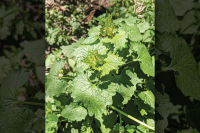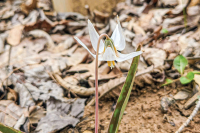After removing sensitive objects, Cherokee museum fills empty cases with artistic responses
Navigating the darkened exhibit halls at the Museum of the Cherokee Indian is slow work on Wednesday evening, Sept. 7. Cherokee people — many wearing traditional ribbon skirts and beadwork — throng the halls, cluster around exhibit cases, and point proudly at the displays of brightly colored artwork that pop alongside the neutral color palette of the archeological objects surrounding them.
Macon County revisits Parker Meadows plans
Discovery of a Cherokee gravesite on the soon-to-be ballfield complex at Macon County’s Parker Meadows property will likely mean that the county has to tweak its design. Though no final decision has been made, a series of meetings between county and Eastern Band of Cherokee Indians leaders has made it clear that the tribe wants the gravesite to stay right where it is.
Construction turns up Cherokee grave in Franklin
Macon County’s project to turn the 48-acre Parker Meadows project into a tournament-level softball and baseball complex met some complications when construction turned up a Cherokee burial site.
“You might hear rumors to that effect, so we’ll go ahead and confirm them,” County Commission Chairman Kevin Corbin said at the board’s July 8 meeting.
Despite outcry, Swain not in the running to house Smokies’ artifacts
The Great Smoky Mountains National Park might finally get a place to store its sizeable cache of historical artifacts, but it almost certainly won’t be in Swain County.
Earlier this year, when the park broke the news about what it’s calling a curatorial collections facility to be built in Townsend, Tenn., Swain County residents were unimpressed.
They packed a Swain County commissioners meeting to vent their spleen, asking why such a trove of historical treasures weren’t going to be located in the county that claims the lion’s share of the parkland.
“Was any consideration given to the fact that Swain County gave more land and our people were given more broken promises than any other county in the park?” Linda Hogue wondered rhetorically. She and others asked commissioners to pitch Swain County as a better location for the place. They pointed out that Swain residents, when displaced by the park’s creation, donated many of the artifacts that would be housed in such a facility and wanted them to be housed locally rather than in Tennessee.
“I’m weary and I’m sure you are, too, of singing a same song, different verse. I’m asking you to go to bat for us. We have land right here close to Bryson City for such a facility,” said Hogue.
Park brass, however, have said that a venue change is unlikely, especially since Swain County already has the park’s only cultural museum at the newly christened Oconaluftee Visitors’ Center at the Smokies’ main North Carolina entrance outside Cherokee.
That, said Swain County Manager Kevin King, is a misconception that has been circling around the project since its announcement. And indeed, many who voiced opposition to a Tennessee location cited the economic benefits of having an added visitor attraction in the county.
But even if the center were located in Swain County, the artifacts in question wouldn’t be set up for public viewing anyway, said Park Superintendent Dale Ditmanson in a letter to commissioners.
“What is proposed is a storage facility not a museum,” said Ditmanson, in the letter.
Currently, the Native American spear points, logging equipment, farm implements, period clothes, weaving looms, moonshine stills and various other relics from the area’s pre-park days are scattered around. Most live in a hard-to-reach facility in Oak Ridge, Tenn. The new facility would bring them together and provide a safer home that would keep them in better shape for longer, and avoid paying rent on a place to house them in off-site.
The real reason the storage house is staying in Tennessee, however, is financial. The park is partnering with four other national parks in that state to split the costs and the space, and a donation of 1.6 acres has already been made for the facility’s footprint. Plus, money was allocated in 2009 and 2010 to build a facility in Tennessee.
“This would be really convenient for us to be able to operate and manage and work with the other parks,” said Nancy Gray, a spokesperson from the Great Smoky Mountains National Park’s public affairs arm. “It would benefit everybody to get all of the artifacts into a central location.”
King agreed, saying that if and when Swain County gets a museum up and running in the historic courthouse — as is on the long-term to-do list for the county — getting some items on loan from the park would be a lot easier, were they in one locale.
Still, said Hogue, having the county’s historical assets in Tennessee is a travesty in the first place.
“A facility of this type would mean so much more to our people than just a building with old things cataloged in it,” said Hogue. “I have talked with many elderly Swain County citizens and they relayed to me that they had donated items to the park with the assurance that they would remain in Swain County.”
The park is still awaiting federal funds for construction, and it was missed out in this year’s allocation. So central storage is still a good few years away. But when it comes, Swain County probably won’t be its final destination.
Ancient burial site halts Jackson bridge construction
Not to say they told you so, but the truth is … they did.
Construction of a wider bridge to span the Tuckasegee River in Jackson County was abruptly postponed this month after Indian burials were discovered. This frankly seemed to surprise only the state Department of Transportation, which had disregarded arguments made by nearby residents and former landowners that it keep bulldozers and such out of the archaeologically rich area.
Keep the project scaled down, the opponents argued. Even though a wider bridge has been planned for more than a decade, initially the state said it would build a new bridge in the same footprint as the old one, leaving the archaeological site untouched. Plans were altered in 2007, however, resulting not only in a much larger footprint, but also shifting the bridge over to sit on top of the site.
Cherrie Moses, whose family owned the land for 120 years, has been a vocal advocate for protecting the archaeological site in a field along the banks of the river. Moses has a long history of tussling over the issue with the state.
“It is an expansive area, which covers many acres near the Tuckasegee River. If work is done almost anywhere in our valley you’re very likely to discover most anything, including burials,” Moses said.
The DOT was supposed to go out to bid on the work in August but has delayed it until March 2012 to allow more time for an archeaological excavation of the site before building over the top of it.
“Protecting the important historical findings we have uncovered during the course of this excavation is vital to preserving the cultural resources of the Eastern Band of the Cherokee Indians and local citizens, as well as all citizens of North Carolina,” said Matt Wilkerson, an archaeologist for the transportation department. “We are prepared to take whatever measure is necessary to proceed with the utmost caution.”
The site was recommended for excavation based on previous archaeological discoveries in the area, although they found more than they bargained for. During the course of the excavation, crews found evidence of burials and at least two prehistoric houses, indicated by distinct patterns of post holes that show the outline of where walls stood.
The excavation was halted last fall because of these discoveries, as well as the onset of cold temperatures. The state said it plans to resume excavation of the site in the next few weeks.
Moses also expressed concern about where unearthed artifacts will go.
“It was my mother’s dream that any artifacts and burials be turned over to the Cherokee Museum including those items which were removed in the 1960s without any written permission from my mother or father. These unique treasures, no matter how small, should remain here within these mountains. They should not be taken to the State Repository where they will never be viewed by anyone from our area,” Moses said.
The $4.2 million will widen the bridge from 20 feet to 50 feet with three lanes, shoulders and a sidewalk to reduce maintenance costs, improve safety and reduce congestion.
Macon airport lands more money for artifact surveys
Opposition to the airport runway extension in Macon County continues to mount, with a standing-room-only crowd attending last week’s Airport Authority meeting and an environmental group threatening to sue and stop the project.
The controversial runway project would pave over Cherokee burial grounds and artifacts. The Airport Authority has agreed to have 25 percent of the artifacts at the site excavated, but the remaining will stay in place and be threatened by the construction.
There are approximately 400 burials at the site, according to an archaeological assessment done on the site in 2000. All of the burials will remain in place at the request of the Eastern Band of Cherokee Indians.
The Airport Authority has been very sensitive to the Eastern Band’s concerns about artifacts and burials at the site, Airport Authority Chairman Milles Gregory said. Excavating 25 percent of the artifacts at the site will cost $535,000. Gregory said 100 percent excavation cannot be done because it would cost around $2 million, which is more than the Airport Authority can afford.
However, Gregory announced at the meeting that the Airport Authority is now attempting to secure additional funding to do “stripping and mapping” of the entire site. He said the Eastern Band is very pleased with this.
Federal Aviation Administration Spokeswoman Kathleen Bergen confirmed that the FAA will provide additional funding for the stripping and mapping, but she didn’t know how much.
Archaeologist Mike Trinkley of South Carolina, who performed the archaeological assessment in 2000, said stripping and mapping does not remove the artifacts and burials from harm’s way. It simply involves taking off the top layer of soil and documenting what is there.
“Simply mapping the site does little in resolving the loss of information,” said Trinkley. “There will be a map showing where stuff was found, but by the time construction begins the stuff will be destroyed.”
Several project opponents at the meeting asked the Airport Authority how it could justify paving over gravesites.
The artifacts are not the only reason opponents are against the runway extension. Some just want to preserve the rural character and peaceful nature of the Iotla Valley.
Many at last week’s meeting were nearby residents of the Iotla Valley and wore buttons urging that the valley be saved.
Dolly Reed of Franklin said she has Cherokee lineage and urged the Airport Authority to “let my people rest in peace.”
Resident Olga Pader said those who live in the valley have been excluded from meetings. Airport Authority member Tommy Jenkins said every Airport Authority meeting has been publicly announced. But Pader noted that there was a private meeting a couple of weeks ago with state, local, federal and Eastern Band officials discussing the project.
County Commissioner Bobby Kuppers, who serves as the Airport Authority liaison, said that was not an official Airport Authority meeting, but was a special conference called by the Eastern Band. Kuppers said the public cannot continue to be suspicious of the county government.
“If this sort of suspicion grows we’re in trouble as a county,” said Kuppers.
A distrust of county officials will destroy the county, said Kuppers, adding that the county commissioners are more open now than they’ve ever been.
The runway extension appears to be getting personal for some, as tempers were flying at the meeting.
Lamar Marshall, with the environmental group Wild South of Asheville, said one of the Airport Authority members called him “crazy as hell” at a recent County commission meeting. Airport Authority member Harold Corbin admitted he was the one who called Marshall “crazy as hell.”
In response to the insult, Marshall wore his Crazy Horse T-shirt to the Airport Authority meeting last week. He said his group is planning a lawsuit against the Authority and others involved in the project.
Corbin became impatient with Franklin resident Selma Sparks, who was trying to speak:
“Sit down, because you’re through,” Corbin told Sparks.
However, not all those in attendance at the meeting last week were against the runway extension. Macon County resident Dwight Vinson said extending the runway 500 feet is good for the county’s economic development.
Franklin resident Norm Roberts agreed that the runway extension is needed for the county to thrive.
“This airport is essential to the economy of the area,” said Roberts.
Others also stated that the runway extension could help bring jobs to the area, but those in favor were heavily outnumbered by those against.
Airport Authority Chairman Milles Gregory said he agreed with some of the statements made by the public and disagreed with others.
Gregory then stated, as he has numerous times in public forums since the controversy erupted about a month ago, that the runway extension has been planned for eight years and that the public has been aware of the project for that long but is just now beginning to express concern.
Want to be on the board?
The five-member Macon County Airport Authority is appointed by the county commissioners for six-year terms.
Terms for members Tommy Jenkins and Harold Corbin are set to expire June 30 of this year, while terms for members Gary Schmitt and Pete Haithcock don’t expire until 2011. Chairman Milles Gregory’s term doesn’t expire until 2013.
The board meets the last Tuesday of the month at 4 p.m. at the Macon County Airport.
Airport officials hold private meeting about runway
Local, state and federal officials involved in the controversial Macon County Airport runway extension held a private meeting last week.
The Smoky Mountain News showed up at the meeting at the airport after being tipped off by an anonymous source.
When a reporter from the newspaper entered the boardroom, Airport Authority Chairman Milles Gregory said it was a “private meeting.”
As the newspaper reporter waited outside for the meeting to end, County Commissioner Bobby Kuppers showed up but wouldn’t comment. Kuppers went into the boardroom.
Airport Authority attorney Joe Collins, who is also the Franklin mayor, came out of the boardroom to speak with the newspaper. Collins said the purpose of the meeting was to update the signers of a Memorandum of Agreement on the progress of archaeological excavation at the site.
He said the goal was to keep everyone informed of the situation.
Asked why the public could not also be kept informed on the progress by sitting in on the meeting, Collins said it was not a meeting the public was entitled to attend.
Collins noted that part of the MOA states that any discussion regarding burials at the site will be done in private at the request of the Eastern Band of Cherokee.
Tribal Archaeologist Russell Townsend, who attended the meeting, also told the newspaper afterwards that burials were discussed and that the tribe prefers that it be kept private.
Townsend said the tribe is pleased with how archaeology is progressing but would still like more of the site excavated before the construction destroys it. He suggested that 60 percent excavation of the site may be a compromise the Tribe could agree to. The Airport Authority is doing 25 percent recovery.
Townsend also said another compromise is that the Tribe could assist Macon County in securing grants to recover 100 percent of the artifacts, but he said he has proposed that for eight years to no avail.
Others in attendance at the meeting were County Manager Jack Horton, State Archaeologist Steve Claggett, Parks Preston from the Federal Aviation Administration of Atlanta, Paul Webb with TRC Environmental — the company doing the artifact recovery, WK Dickson Project Engineer Eric Rysdon of Charlotte, FAA Environmentalist Lisa Favors, and Tyler Howe of the Cherokee Tribal Historic Preservation Office.
The officials participated in a conference call with the Cherokee Nation in Oklahoma, Collins said.
Runway extension faces funding shortfall
The Macon County Airport Authority is short about $853,000 of what it needs to pay for a controversial runway extension, according to airport officials.
The total runway project, including archaeology and engineering, is expected to cost $3.5 million, according to Airport Authority member Tommy Jenkins.
Airport Authority Clerk Teresa McDowell said about $777,000 has already been spent or committed for archaeology and engineering on the project.
According to McDowell, it will cost the Airport Authority about $1.87 to million finish the runway, which means the Airport Authority is about $853,000 short of what it needs, she said.
The airport runway extension is controversial because it is proposed to go over Cherokee artifacts and burial grounds. The Airport Authority is only funding 25 percent artifact excavation, which angers the Eastern Band of Cherokee and others who say 100 percent of the artifacts should be saved to prevent their destruction.
Airport Authority Chairman Milles Gregory said the project is being funded with 80 percent federal funds, 10 percent state and 10 percent county funds.
The N.C. DOT Division of Aviation took back $550,000 from a grant last year because the money wasn’t used by the Airport Authority in time, McDowell said.
It is unclear where the money went. N.C. DOT Grants Administrator Nancy Seigler was unable to answer questions before press time on Tuesday.
The grant, which was awarded in 2004, wasn’t used in time because the project was held up by negotiations between the Airport Authority, Eastern Band of Cherokee Indians Federal Aviation Administration, State Historic Preservation Office and the Division of Aviation. The negotiations concerned how much excavation of Cherokee artifacts would take place at the project site, McDowell said.
The Airport Authority hopes to get the $550,000 back.
Airport Authority Chairman Gregory said he was promised by Richard Barkes, manager of Aviation System Development for the N.C. DOT Division of Aviation, that the $550,000 would be reimbursed.
McDowell said the Airport Authority has been told over the phone by the Division of Aviation that it would be reimbursed the $550,000 in the form of a new grant. But McDowell said the Airport Authority hasn’t received the grant documents yet.
Even if the Airport Authority gets the $550,000 back it will still have a shortfall of about $303,000.
McDowell said the Airport Authority is “optimistic” that more funding will become available to cover the shortfall. Gregory said he thinks the remaining shortfall can be made up with $150,000 “Vision 100” grants that the Airport Authority receives annually from N.C. DOT Division of Aviation. It is unclear if the Vision 100 money is state money or federal funds that pass through the N.C. DOT Division of Aviation.
McDowell said the $550,000 that was taken back was supposed to be used for the environmental assessment for the project. Because that money was taken back, McDowell said the Airport Authority is now using money from its construction grant on the environmental assessment.
County funds in play
Some have urged the county commissioners not to commit county taxpayer dollars to the project. Withholding the county match for the project could sideline it.
According to County Finance Director Evelyn Southard there is $187,000 in county funds currently budgeted for the project.
Southard did not know what year the county appropriated the money.
County Commissioner Bob Simpson has proposed pulling the county dollars from the project unless a compromise between the Airport Authority and Eastern Band is reached.
However, Simpson seems to be alone in that the other commissioners appear to favor moving forward.
Commissioner Brian McClellan told The Smoky Mountain News he doesn’t “have an opinion at this time” but “it would appear” that county dollars are not going to be pulled from the project. McClellan said there is “always a chance” funding could be pulled.
Commission Chairman Ronnie Beale said he feels that the Airport Authority has “done due diligence” in the project.
Beale said there is no doubt that the runway extension is needed to keep insurance costs down for pilots who land there. No one has said the runway extension is not needed, Beale said.
However, several people have publicly said that they don’t think a runway extension is needed.
As far as taking the county dollars from the project, Beale said that money was “appropriated a good long time ago.”
He added that the grants are a good opportunity because they only require a 10 percent county match. Anytime the county can get something done for 10 cents on the dollars it’s good, said Beale.
Artifacts endangered by airport project
When Neal Hoppe dies he wants his body cremated and his ashes spread over the Macon County Airport.
“When I die, my soul will depart my body,” said Hoppe, who manages the airport’s terminal. “I don’t want a hole dug for me.”
The Macon County Airport is the best place to scatter his ashes because, “It’s a beautiful place,” said Hoppe as he drove down the airport’s taxiway.
Once Hoppe’s ashes are spread at the airport, he will join Cherokee Indians who made the Iotla Valley their resting place hundreds of years ago.
The Cherokee bodies buried at the site are now a huge source of controversy because the airport’s runway is proposed to be extended over the gravesites. The project has upset many people who think the Macon County Airport Authority and state and federal agencies are desecrating the Cherokee heritage.
The Airport Authority, however, says archaeology recovery is taking place, burial sites will not be disturbed and state and federal laws are being followed.
The runway extension seemed like a sure thing just a week ago but is now facing opposition from all fronts. Necessary federal permits are still pending for the project, the environmental assessment hasn’t been finalized, legal action from both environmentalists and the Eastern Band of Cherokee Indians has been threatened, one county commissioner wants to withdraw local funding for the project and the Airport Authority’s argument that the project is needed for safety has had a hole shot in it.
Solid legal footing?
Airport Authority Attorney Joe Collins said he thinks the Airport Authority is on solid legal grounds.
Cherokee Attorney General Annette Tarnowski said there has not been any decision made by the Cherokee in terms of what, if any, legal action to take. The Tribal Council is looking at all its legal options, but Tarnowski would not elaborate.
It is a matter of great concern to the Cherokee because of the number of gravesites, she said.
The controversy has been eight years in the making and is coming to a head as archaeologists are now working on excavating the artifacts at the site to prepare to extend the 4,400-foot runway by 600 feet.
The problem is that artifacts are only being removed from 25 percent of the five-acre area that will be impacted by the project. The remaining artifacts will be left in place.
Members of the Eastern Band of Cherokee Indians and a contingent of other concerned citizens are outraged that the Airport Authority, the Federal Aviation Administration and the state archaeologist would allow artifacts and human burials to be put at risk.
Those against the project, including Cherokee Principal Chief Michell Hicks, said 100 percent of the artifacts should be excavated before it is paved over. Failure to do so could erase the archaeological record. Hicks said there could be some protests coming to Franklin.
But Airport Authority Chairman Milles Gregory said it would cost $2 million to do total artifact recovery — money the Airport Authority doesn’t have. The Airport Authority has contracted with TRC Environmental of Chapel Hill for $535,000 to recover the 25 percent. Hicks said the tribe is unwilling to pay the difference to do a complete excavation, saying it is the responsibility of the county and Airport Authority to do the right thing.
The entire runway project is expected to cost around $3.5 million, according to Airport Authority member Tommy Jenkins. County officials say the project is being funded 90 percent with N.C. DOT Division of Aviation grants and a 10 percent match from the county.
State archaeologist endorses project
So far, four archaeologists have weighed in on the project. Two support the runway project moving forward, while the other two believe it is an abomination.
The one whose opinion matters most, however, is State Archaeologist Steve Claggett. Claggett decided how much of the site must be excavated before the runway project could move forward. He settled on 25 percent excavation, saying 100 percent is unnecessary because it wouldn’t result in learning anymore about the Cherokee. Moreover, Claggett said many of the artifacts at the site are damaged anyway from being plowed up when the land was farmed.
Claggett said the project is being done in accordance with all state and federal laws. However, some archaeologists disagree with Claggett and say 100 percent artifact recovery should occur.
An archaeological survey done on the site in 2000 indicated the presence of some 400 burials and numerous artifacts.
Claggett said the goal is to focus the artifact recovery on the areas that were identified as having the highest concentrations of materials. So even though artifact recovery is only occurring on 25 percent of the five acres, more than 25 percent of the artifacts may actually be recovered, Claggett said.
As far as the burials go, they are remaining in place at the request of the Cherokee. If remains are accidentally uncovered during work, “all work will cease within 50 feet of the remains,” according to a memorandum of agreement signed by the Airport Authority, Federal Aviation Administration, State Historic Preservation Officer Jeffrey Crow and the North Carolina Department of Transportation. The Cherokee refused to sign off on the agreement.
Archaeologist against project
Columbia S.C. archaeologist Michael Trinkley is appalled at the minimal artifact recovery taking place at the site. Too little work is being done considering the value and significance of the site, he said.
Trinkley is the archaeologist who performed the initial assessment in 2000 and said burials and artifacts will be destroyed. He said he thinks about 250 burials will be destroyed.
“I think it’s terribly disrespectful,” Trinkley said.
If it is not stopped, one of the more important archaeological sites in the state will be destroyed, he said. The burials will be destroyed when soil is removed, when equipment bogs down, when soil compacts and when fill is brought in, Trinkley said.
But Airport Authority Chairman Gregory said the earth will not be cut into during the project, meaning the burials will not be destroyed.
The burials could have been removed from harms way using appropriate techniques, such as hiring Cherokee elders and a shaman for reburials, said Trinkley.
But this did not occur because the Airport Authority never made any effort to reach a compromise with the Cherokee, he said. The Airport Authority denies this, saying it tried for eight years to work out an agreement with the Cherokee to no avail. Furthermore, the Cherokee specifically requested that the burials be left in place.
Trinkley said that the Airport Authority attempted to hide the project from the public rather than discuss it.
The manner in which the project has been handled is “corrupted,” he said.
As for other archaeologists in the mix, Russ Townsend, an archaeologist for the tribe, is opposed, while the archaeologist who landed the half million contract to do the partial excavation work is in support of it.
FAA has final say
The FAA is the ultimate authority on the project, said Claggett. The main law that had to be followed in regards to the archaeology at the site was Section 106 of the National Historic Preservation Act.
According to Claggett, the law does not specify a “magic number” when it comes to how many artifacts have to be removed from a site.
Advisory Council on Historic Preservation spokesman Bill Milhans in Washington agreed that all the law requires is for the impact on archaeological sites to be considered. He said how much artifact recovery takes place depends on the significance of the site.
In this case, FAA consulted with the State Historic Preservation Office and decided 25 percent artifact recovery would be sufficient. Milhans said ACHP agreed that 25 percent artifact recovery is in accordance with Section 106.
Environmental Assessment questioned
An environmental assessment done by the project engineer WK Dickson of Charlotte states that the project will have “no significant impact” on the environment, artifacts or burials at the site.
The consultant’s findings were adopted as the official stance of the N.C. Division of Aviation, which holds the purse strings to the federal grant money paying for the runway expansion.
The state agency ruled that the project is in accordance with the National Environmental Policy Act and will not “significantly affect the quality of the human or natural environment.” The public can make comments on the environmental assessment and dispute the finding of no significant impact to the State Environmental Review Clearinghouse until March 17.
Trinkley complained that there isn’t even a copy of the document to review locally, making it difficult for people to comment on something they don’t have access to. Trinkley wondered if that is illegal.
Further, Trinkley questioned the legality of the Airport Authority moving forward with artifact recovery prior to the environmental assessment going through the public comment period. Trinkley has submitted a letter to the State Environmental Review Clearing House disputing the finding of no significant impact.
Lawsuit threatened
Macon County resident Lamar Marshall said the environmental assessment is flawed and plans to sue on the grounds of violations of the Endangered Species Act and the National Environmental Policy Act. He said the environmental assessment is flawed because it contains out-of-date information that does not take into account species that have been listed as endangered in the past 10 years.
The Airport Authority failed to consult with the U.S. Fish and Wildlife Service in regards to endangered species, said Marshall.
“The current EA is a cheap and erroneous shortcut that failed to disclose the cumulative impacts of serious environmental issues...,” said Marshall.
The Airport Authority also needs a water quality permit from the U.S. Army Corps of Engineers to proceed. Lori Beckwith, a biologist with the Corps in Asheville, said the Airport Authority submitted an incomplete permit application. Once the Corps gets a complete permit it will be open for public comment for 30 days, she said.
What is the need?
Gregory and other Airport Authority members have stressed that the project is needed to make the runway safer. Gregory has repeatedly noted that a husband and wife died in an airplane crash at the airport in 1995 because the runway was too short. Gregory said a life is more important than artifacts.
But Macon County resident Michael Wyrick said the report from the National Transportation Safety Board indicates that the runway length had nothing to do with the crash.
The cause of the crash was determined to be a “the pilot’s failure to maintain flying speed resulting in an aerodynamic stall. A factor was sun glare,” the NTSB report states.
“From this we can see the aircraft never made contact with the runway and therefore the extra 600 feet of runway would not have helped,” Wyrick said.
And he said the plane that crashed was certified to operate on a 2,000-foot runway, so Macon’s 4,400-foot runway should have been ample.
When asked to comment on the crash report’s assertion that the accident was not a result of the runway being too short, Gregory said he had no comment.
Wyrick said he has been a licensed pilot of the past 28 years and was in management at the Asheville airport for 15 years, and he doesn’t think the runway extension is necessary.
He said if there were a lot of large companies wanting to fly in and out of the airport it might be necessary, but that is not the case. He added that the last accident that occurred at the airport was eight years ago.
Voicing opposition
About 10 residents vented their opposition to the project at the Macon County commissioners meeting on Monday (March 9).
The residents said it is disrespectful to the Cherokee to destroy artifacts and burial grounds.
The commissioners took no action on the comments.
Some residents said if it were a white graveyard it would be looked at differently.
The county’s real strength is in its cultural heritage and it should be protected, the residents said.
Resident Kathleen Walker questioned whether a runway extension is necessary. She said rushing to meet a grant deadline is no reason to extend the runway.
Other residents said an extended runway will decrease the quality of life for the area by bringing in more and larger airplane traffic.
The Airport Authority has stressed that the Macon County Airport will never be used for commercial flights. Gregory has said that once the runway is extended to 5,000 feet it won’t have to be extended again.
Resident Norma Ivey said there is a petition circulating with 84 signatures already against the project. And resident Susan Ervin said Macon County has always worked hard to protect its heritage and should do the same in this case.
Tribal Historic Preservation Office archaeologist Russell Townsend told the commissioners he wants to seek a compromise with the Airport Authority. Townsend said he did not have a specific compromise in mind.
‘No room for compromise’
Gregory told the commissioners there is no room for compromise. Gregory said he thinks his board has done everything it can to accommodate the Cherokee.
The project can’t be delayed because the grant money could be lost, said Gregory.
Commissioner Bob Simpson asked Gregory how long the Authority has before it loses the money, but Gregory didn’t know.
Simpson said he supports pulling the county’s 10 percent match from the project if 100 percent artifact recovery isn’t done. But he does not know if the money can be pulled because it was committed years ago.
However, Commissioner Jim Davis said he is “comfortable” with 25 percent artifact recovery.
Commissioner Bobby Kuppers said he thinks more information needs to be exchanged.
Townsend said it doesn’t appear to him that the county commissioners are going to step in and try to change anything.
Economic impact
The Macon County Airport brings in about $7.9 million annually, according to a N.C. DOT Division of Aviation study from 2006.
Airport Fixed Base Operator Neal Hoppe said if the runway were extended more businesses may come in. Macon EDC Chairman Mark West supports the project for its economic development potential.
A longer runway would make insurance on airplanes more affordable, said Hoppe.
Caterpillar does not fly into the Macon County Airport because the runway isn’t long enough, Hoppe said. Caterpillar said it was not taking a position on the issue of whether the runway should be lengthened and offered no further comment.
At 4,400 feet, Macon’s airport is longer than Jackson County’s, which is only 3,200 feet. But it is shorter than the Andrews/Murphy Airport has a 5,500-foot runway where some planes would rather fly into, said Hoppe.
There are about 30 planes registered at the Macon County Airport, said Hoppe.
Hoppe balks when people say that taxpayer money is being spent on a “rich man’s playground.”
The airport is an “economic stimulus” to the county, bringing in people who purchase things here, said Hoppe. Many who fly here have second homes in Highlands, he noted.
John Makinson has a two-seater Cessna at the airport and said the runway length is fine for a plane his size, but he said corporate jets and cargo planes need more runway.
Whether the runway extension is actually needed depends on the type of growth Macon County has, said Makinson.
New park visitor center to showcase stored artifacts
A design has been finalized for a new $3 million visitor center at the North Carolina entrance to the Great Smoky Mountains National Park outside Cherokee.
The new visitor center will focus on the cultural history of the park, from early Native Americans to Appalachian heritage. The park has thousands of artifacts collected from people who once lived in the park, but they are locked up in storage since the park has nowhere to display them. The new visitor center will finally put the public in touch with some of these implements of early life, from spinning wheels to farm tools to moonshine stills.
“We are going to be using those artifacts to tell the story of the people who lived here,” said Kent Cave, a park ranger who supervises visitor outreach with a specialty in Appalachian studies. “This is a fulfillment of a dream and of a promise.”
Cave said the original plan for the park dating back to the 1940s called for a cultural heritage museum on the N.C. side of the park, while the visitor center on the TN side focuses on ecology and natural history of the Smokies.
The cultural heritage theme will dovetail with the Mountain Farm Museum already in place at Occonaluftee, where visitors can see old farm buildings and demonstrations of early life.
“You aren’t just talking about the stuff, you are out there with it,” said Bob Miller, spokesperson for the park. “You can feed the chickens and talk to people about what they are seeing. This will be an extension of the farm.”
Miller said the park will judiciously select which artifacts go on display, since the park has far more than the new visitor center can possibly hold.
“A tiny portion of this stuff will be on display, just like at the Smithsonian where only a tiny portion of what they have is displayed for the public,” Miller said.
The current visitor center at Occonaluftee is old, cramped and doesn’t do justice to the most visited national park in the country.
Nearly 2 million people crossed into the park via the entrance on U.S. 441 last year, passing by the doorstep of the visitor center. Only 350,000 people ventured inside, but far more might stop in if it offered more in the way of exhibits.
The old visitors center was constructed in the 1930s by the Civilian Conservation Corp with the intention of serving merely as a ranger station. It is only 1,100 square feet, while the new one will be almost 7,000.
The old visitor will be converted to classroom space. The new visitor center will be constructed beside it. The parking lot will be reconfigured, along with the entrance off U.S. 441.
“We are extremely excited about having a new state-of-the-art facility,” said Park Superintendent Dale Ditmanson.
Ditmanson lauded the fundraising that will pay for the entire cost of the new center.
The Great Smoky Mountains Association, which operates bookstores in the park, has committed $2.5 million for its construction. The Friends of the Smokies will provide the $500,000 to design and create all the maps, exhibits and displays.
The visitor center will meet national certification standards as an environmentally friendly building under LEED (Leadership in Energy and Environmental Design).
“The new Center is being designed be as energy efficient and sustainable as we can make it,” Ditmanson said.
Some of the environmental designs being considered are
• Geothermal Heat and Cooling: The heating and cooling system will take advantage of the constant 55 degrees temperature of the earth, by pumping water into the ground though tubing where it will gain or give off heat, increasing the efficiency of the system.
• Passive solar: The orientation of the building and the select placement of windows will allow plenty of sunshine into the building and also provide heat. Working with the Oak Ridge National Laboratory, the Park has taken solar measurements where windows are to be placed, to be sure they are sized correctly, to allow just the right amount of light, and offset the need for heat.
• Rain water cistern: A cistern will be collect rain water from the roofs. The water will be filtered and then used to flush toilets.
• Water Saving Fixtures: Bathroom fixtures will use waterless urinals and water saving water faucets and toilets.
• Recycled Materials: Everything from roofing materials, to cabinets, siding, and structural supports will be made of recycled materials.
• Landscaping: Natives plantings will be used that will not require extensive watering after they become established.









